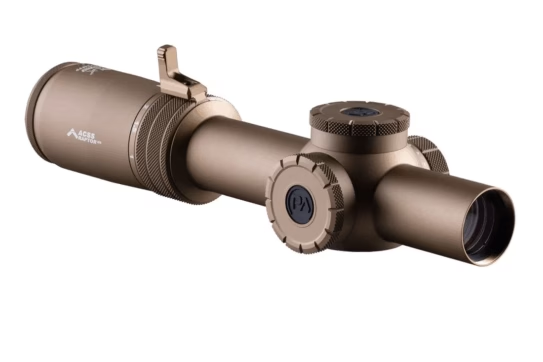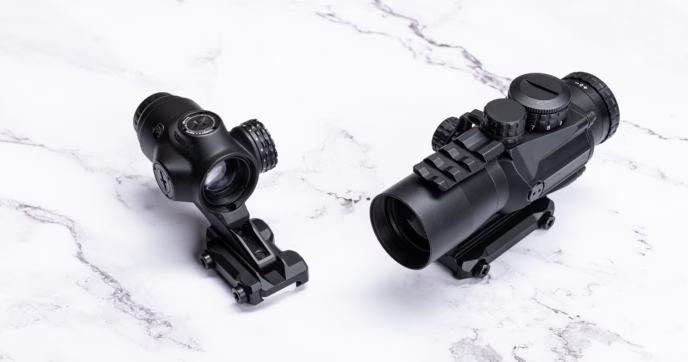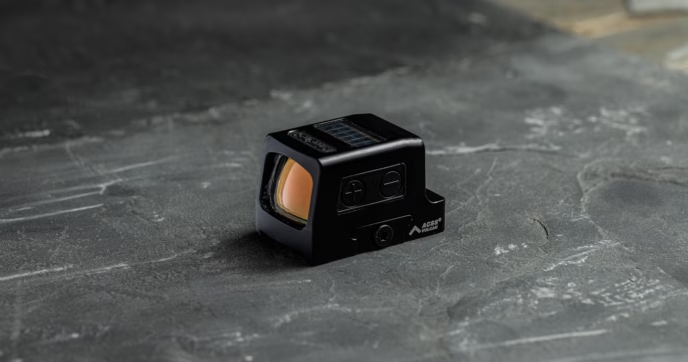When shooting across varying distances, there are few optic setups that offer the same level of performance as rifle scopes. By design, they provide you with a solid point of aim and a magnified image of your target, giving you a full picture of your target and a specialized reticle to keep your shots as accurate as possible.
And as optics technology has continued to become increasingly advanced, rifle scopes have become even more specialized, with there now being a plethora of options to choose from. Among such options are Low-Power Variable Optics, better known as LPVOs.
LPVOs are one of the standout optic choices for modern rifle builds, as they offer both close- and long-range versatility. However, a cursory search for LPVOs often leaves newer enthusiasts with more questions than answers, as the sheer variety of options can be overwhelming.
And, just like their prism scopes we went over in Behind the Glass Part One, Primary Arms Optics has a lot of LPVOs in their lineup. So, to make shopping for PAO LPVOs as easy as possible, we’re going to break down what exactly LPVOs are, as well as the various models offered by PAO. Welcome to Behind the Glass Part Two!

What is an LPVO?
As mentioned above, the term ‘LPVO’ is an acronym that stands for “Low-Power Variable Optic”, which is a type of variable power optic with a lower magnification range. When most enthusiasts hear the phrase “variable power optic” or “rifle scope”, the first thing that often comes to mind is the larger medium- and high-power optics that you’ll typically see on kitted out long-range rifle builds. But LPVOs look different, as they aren’t just designed for long-range use.
LPVOs typically use either 1-6x, 1-8x, or a 1-10x magnification range, though there are some models with even lower ranges like 1-4x. Either way, their magnification ranges are much lower than what’s standard on most MPVOs and HPVOs. While this might sound like a disadvantage at first, it gives LPVOs a level of adaptability that just isn’t available with higher power rifle optics.
At 1x magnification, they perform like reflex sights, offering a wide field of view (FOV) and fast target acquisition speed. Although they aren’t quite as agile since they have a narrower eye box, with some training, they can be used to significant effect. And even though an LPVO won’t offer the most in terms of long-range performance when compared to higher power scopes, when magnified, they can reach out to distances as far 800+ yards in some instances, allowing you to engage targets at further distances with ease.
How do LPVOs compare to other Popular AR Optics?
With all their benefits, it’s easy to understand why LPVOs have become such a popular optic for everything from general-purpose rifle builds and battle rifles, to SPRs and DMRs. But how do they stack up against some of the AR platform’s other popular optic setups?
Starting with arguably the most popular AR optic, red dot sights are designed for close-range agility, but when paired with a magnifier, they can be effective for engaging targets at further distances. However, adding a magnifier to your red dot won’t magically turn it into a long-range powerhouse. While usable when engaging far off targets, they’re often limited by their reticle, since red dot sights don’t typically have reticles tailored for long-range use. Compared to LPVOs though, red dot sights win out in terms of agility—their wider FOVs and more forgiving eye boxes make them better suited for close-range use. However, LPVOs provide the magnification and reticle designs needed for long-range precision, giving them a significant edge over reflex sights.
Next up are prism scopes, which we covered in Behind the Glass Part One. Regarding 1x prism scopes specifically, just about everything we said about reflex sights can be applied to them. Even though they can have specialized reticles with added ranging info like the ACSS® Cyclops®, they’re still easily outclassed at distance by LPVOs. Magnified prism scopes provide more utility than their 1x counterparts, especially at a distance. However, being locked into one specific magnification level makes them less adaptable across various ranges. Granted, an offset optic will allow you to switch from magnified to non-magnified rather easily.
To keep things open and honest, there isn’t one optic that’s universally considered “the best”. Choosing an optic comes down to finding the one that best fits your needs and preferences. For many, that means having an optic that can excel across both close-quarters and ranged applications, making an LPVO one of the best tools for the job. For some more insight into how LPVOs stack up against other optics, our guide on Comparing LPVOs and Red Dot + Magnifiers goes more in-depth into each optic setup’s respective performance.
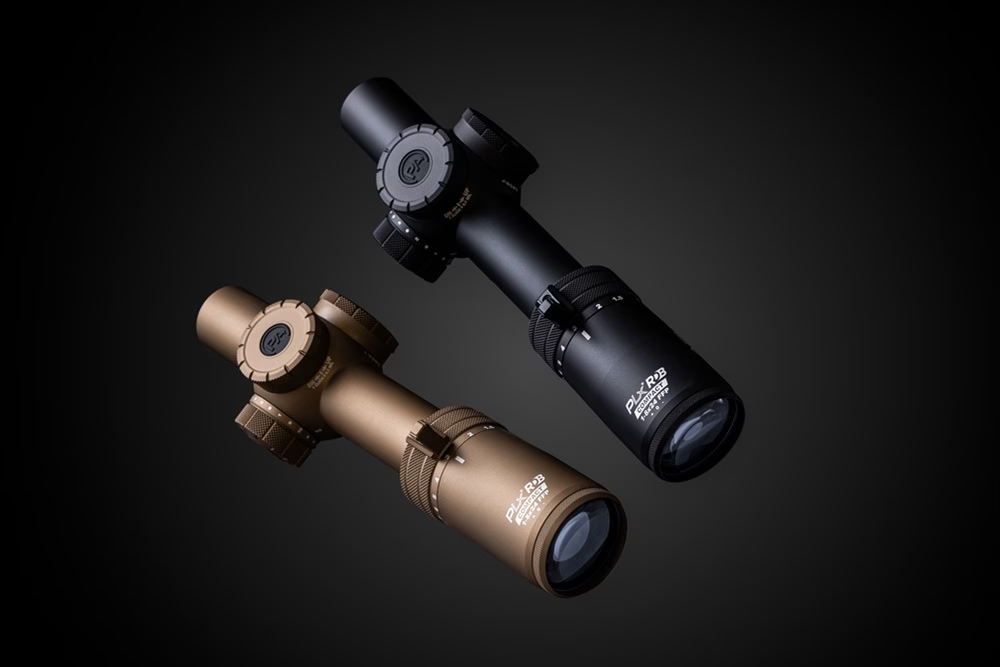
The Primary Arms LPVO Family
As far as LPVOs go, they make up some of the most popular optics offered by Primary Arms Optics. And, as we mentioned all the way back in the beginning, PAO offers quite a few unique LPVO options. Now, a cursory search for LPVOs can leave you confused, especially when there’s so many different models and reticle options to pick from. As such, there’s a lot to cover when searching for one, and below, we have a breakdown of the different LPVOs offered by PAO.
SLx LPVO Series: Dependable Performance at Every Level
PAO’s SLx® line of optics was created to offer something for everyone, providing you with a premium quality optic packed with features, all without forcing you to spend an exorbitant amount of money on it. Despite being one of PAO’s more entry-level optic tiers, these optics go through rigorous quality control checks to ensure that they’re ready for anything, making them incredibly reliable. Furthermore, each SLx optic is made from high-quality parts and materials, ensuring that they’re ready for use across all applications.
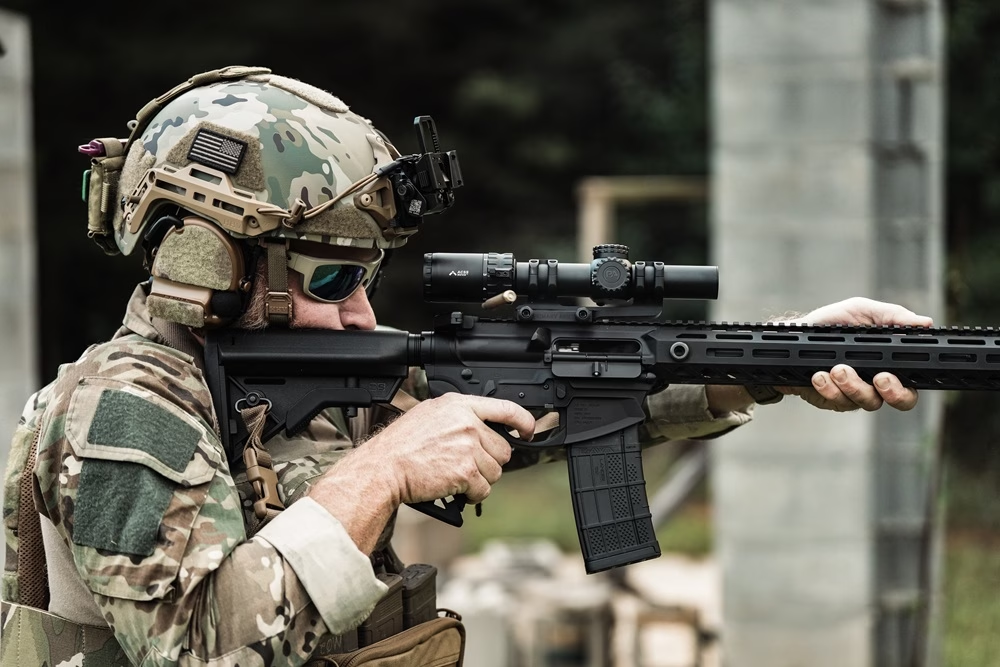
SLx 1-6x24mm SFP Rifle Scope
The SLx 1-6x24mm SFP Rifle Scope Gen IV – ACSS® NOVA® is one of the most adaptable budget-friendly LPVOs on the market, and as mentioned above, it comes absolutely packed with features, making it strong contender against other LPVOs of its caliber. For starters, this rifle scope houses the exceptionally versatile ACSS NOVA fiber wire reticle, which is among the brightest in its class.
On its crosshairs, the NOVA reticle has built-in MIL subtensions, moving target leads, and target ranging data for making on-the-fly holds when engaging targets at distance. Plus, its built-in fiber optic element creates a truly Red Dot Bright™ center dot. With it being a second focal plane (SFP) optic, the reticle stays the same size, regardless of your magnification level. This comes with the caveat of the reticle’s holdovers only being accurate at its maximum magnification. Still, it’s a rather versatile optic that’s adaptable for most applications—it can effectively range out to 600+ yards and is agile enough for use at close range.
The SLx 1-6x SFP Rifle Scope with the ACSS NOVA reticle is available in multiple variations too, with them coming in different finishes, and with either red or green center dots. There’s even a BDC variant of the ACSS NOVA that’s calibrated specifically for 5.56 NATO and .308 Winchester. Regardless of which one you look at though, they all boast incredibly long battery lives that are further enhanced thanks to their use of AutoLive® motion-sensing illumination, and since they have 30mm diameter, they’re compatible with a plethora of Primary Arms Scope Mounts too.
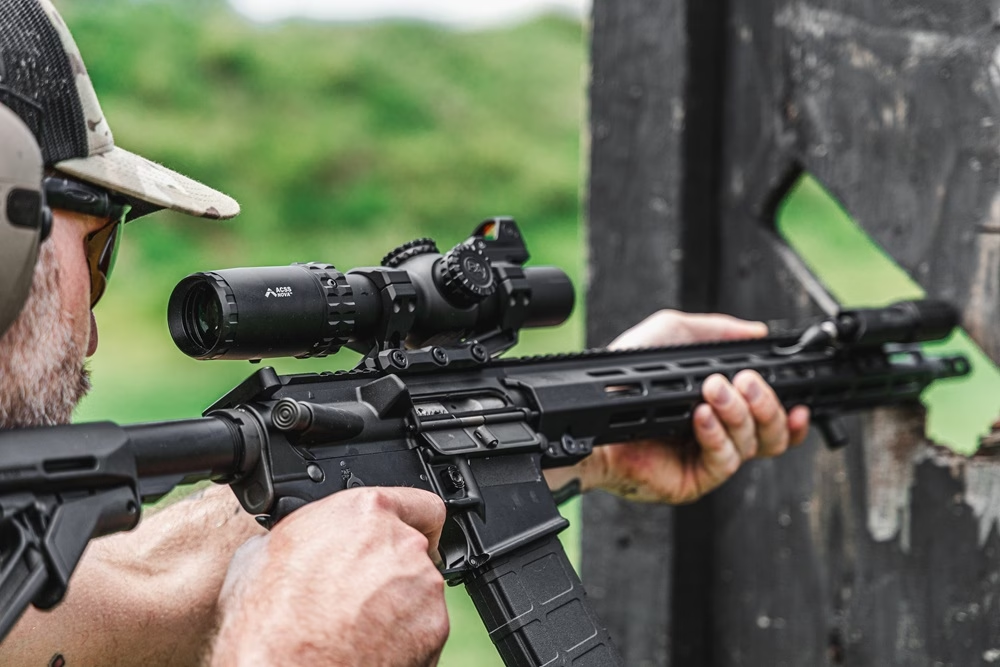
SLx 1-10x28mm SFP Rifle Scope
The SLx 1-10x28mm SFP Rifle Scope – ACSS Nova is a slightly larger optic, boasting a wider magnification range than the 1-6x Rifle Scope mentioned above. Coming with many of the same features, including AutoLive motion-sensing illumination, a durable optic body, and exceptionally clear lenses, it’s marginally bigger than the 1-6x LPVO, measuring 10.5 inches long and weighing 19.4 ounces. Compared to other 1-10x LPVOs though, it’s still exceptionally light and maneuverable, making it one of the go-to AR-15 scope options
Another noteworthy difference is its tube diameter. With its larger objective lens and more extreme magnification ratio, this scope has a 34mm tube diameter instead of a 30mm one.
PLx Compact Series: Premium Glass, Advanced Reticles
PAO’s PLx® series of optics consists of some of the industry’s top optics. Engineered to handle the worst conditions that professional-level applications can throw at them, every PLx optic is outfitted with innovative, industry-leading technology, and they’ve all been meticulously crafted to offer nothing short of top-tier performance. As such, PLx LPVOs shoot for the height of what premium optics are capable of.
PLx LPVOs are designated as PLxC® optics, with the ‘C’ simply standing for ‘Compact’. These optics come equipped with a plethora of PAO’s technologies, such as AutoLive motion-sensing illumination and an automatic shut-off feature. But these optics are designed to be the best. PLxC LPVOs have much more robust optic bodies and come with some notable upgrades such as premium Japanese ED glass lenses, enhanced SOS® windage and elevation turrets, and a completely waterproof, shock, and fog resistant optic body. Plus, they house more specialized reticles too. Now, there’s a lot to cover when looking at the PLx reticles, but our guide, “Understanding the PLx Reticles” will get you up to speed on what you need to know.
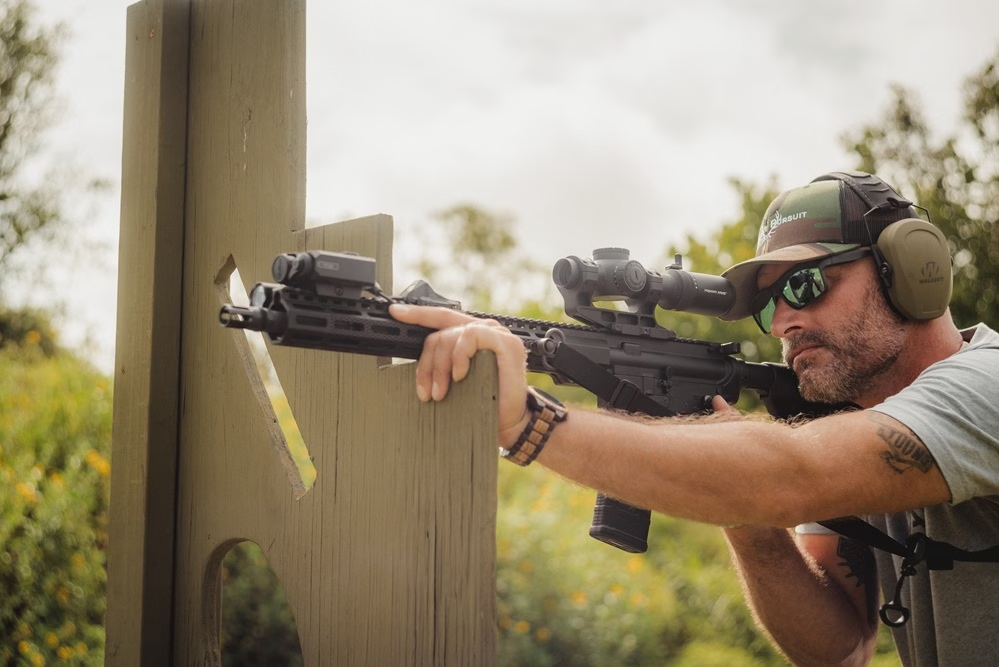
PLxC 1-8×24 FFP RDB Rifle Scope with the ACSS Raptor G2 Reticle
One of the newest entrants in the PAO LPVO line is the PLxC 1-8×24 FFP RDB Rifle Scope – ACSS Raptor 5.56/.308 Yard G2 Reticle. This optic comes outfitted with all the top-tier features mentioned above, and as its name suggests, it houses the all new RDB ACSS Raptor G2 Reticle. This reticle is highly specialized, offering exceptional performance across both close- and long-range—it’s comprised of an infinitely precise center chevron aiming point, an outer horseshoe for fast target acquisition, horizontal and vertical ranging stadia, moving target leads, and BDC holds calibrated for 5.56 NATO and .308 Winchester that can also range out to 800 yards.
At 1x magnification, these optics perform remarkably like red dot sights as the newer RDB design with its innovative diffractive reticle technology provides you with a truly Red Dot Bright reticle (hence the name ‘RDB’). Simply put, RDB reticles are some of the most advanced ones on the market; micro-etched onto the reticle is a highly reflective grating that intensifies the brightness of the optic’s emitter diode. As such, it’s far brighter than PAO’s previous optic generations, and since it’s compact and lightweight, it has quickly become one of PAO’s more sought-after LPVOs in their lineup.
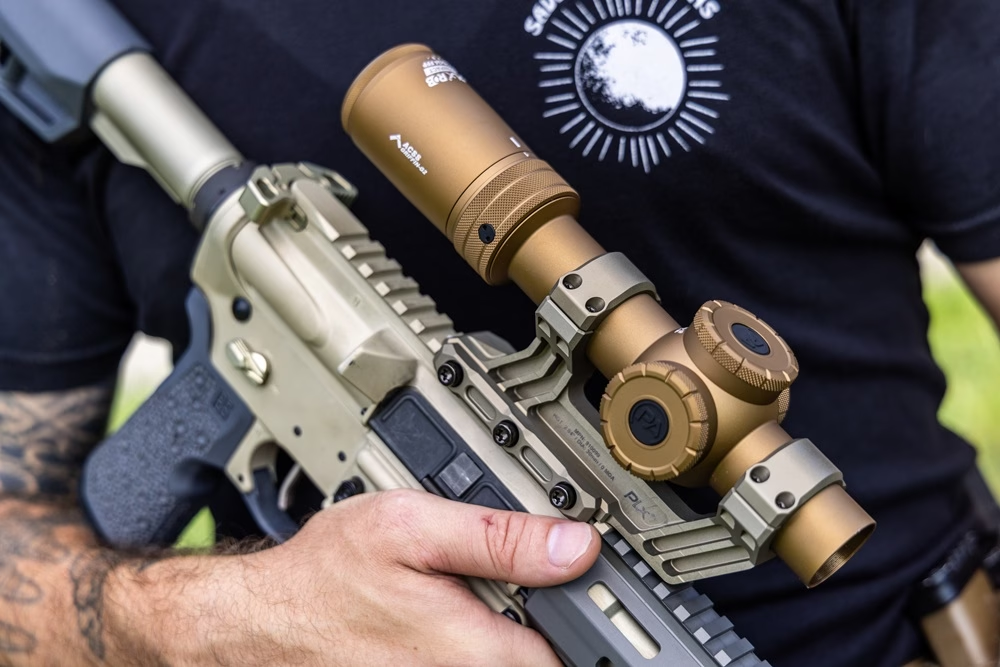
PLxC 1-8X24 FFP RDB Rifle Scope with the ACSS Griffin MIL G2 Reticle
Another optic that makes use of PAO’s new RDB technology is the PLxC 1-8X24 FFP RDB Rifle Scope – ACSS Griffin MIL G2, a solid LPVO that’s geared more towards precision and adaptability with various calibers. As denoted in its title, this optic houses the ACSS Griffin MIL G2 reticle, which, like the ACSS Raptor Yard G2 reticle, makes use of the same reflective micro-etched grating to achieve as bright a reticle as possible.
The ACSS Griffin MIL G2 shares a lot in common with the Raptor Yard G2, but the two designs aren’t one-to-one. For instance, the Griffin MIL G2 retains the infinitely precise center chevron, outer horseshoe, and the vertical and horizontal ranging stadia, but rather than having BDC holds, the Griffin MIL G2 comes outfitted with a full MIL grid. This MIL grid makes this optic compatible with multiple calibers, and it also allows you to make more complex holds at distance, so long as you know how to measure in MILs. Also, since MIL grids aren’t caliber-specific like BDC elements, these optics are used on everything from AR platform rifles to compact bolt-action rifles chambered in unique calibers.
Although it isn’t a dedicated precision scope, it can still range out to 800 yards with ease, making it a good pick for SPR and DMR builds. Still, if long-range precision is your primary goal, we recommend checking out our guide, “LPVO vs. Precision Rifle Scopes”, to get a better idea of how they stack up against each other.
Conclusion
LPVOs are some of the best “do-all” optics available, offering solid performance in both close-range and medium- to long-range applications. Being a true jack of all trades, it’s no surprise that they’re some of the most popular optics for platforms like the AR-15, AR-10, and other semi-auto rifles. And after factoring in all the features that PAO has packed into their LPVO models, it’s easy to see why they’re so sought-after.
Although there isn’t one single “best LPVO”, knowing what’s behind the glass will give you the best chance possible to find the one that matches your needs. Whether you’re searching for a budget-friendly optic that can handle regular range trips and field use, or a professional grade optic built to withstand harsh use in adverse conditions, PAO has what you’re looking for.
If you haven’t checked out Behind the Glass Part One, it provides you with an in-depth look into prism scopes, another popular optic for the AR platform. In part three, we’ll be moving over to pistol optics, focusing on PAO’s mini-reflex and pistol red dot sight options. Stay tuned!
